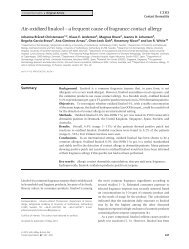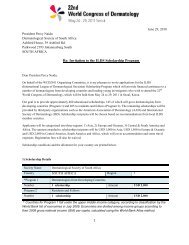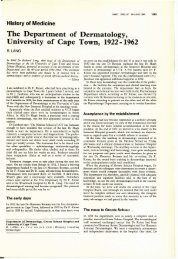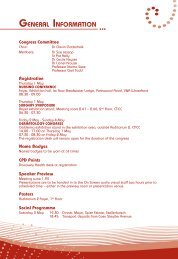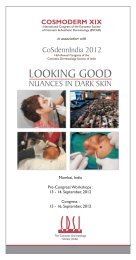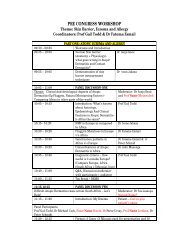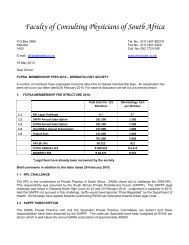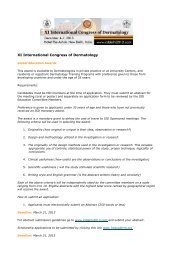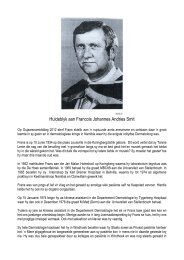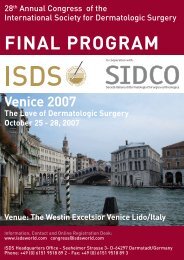Guidelines on the Management of Atopic Dermatitis ... - Dermatology
Guidelines on the Management of Atopic Dermatitis ... - Dermatology
Guidelines on the Management of Atopic Dermatitis ... - Dermatology
Create successful ePaper yourself
Turn your PDF publications into a flip-book with our unique Google optimized e-Paper software.
References<br />
1. Ackerman AB. „Eczema‟ revisited. A status report based up<strong>on</strong> current textbooks <strong>of</strong>dermatology.<br />
Am J Dermatopathol 1994; 16: 517-22; discussi<strong>on</strong> 523-531<br />
2. Ackerman AB. A plea to expunge <strong>the</strong> word „eczema‟ from <strong>the</strong> lexic<strong>on</strong> <strong>of</strong> dermatology and<br />
dermatopathology. Arch Dermatol Res 1982;272:407-20<br />
3. Johanss<strong>on</strong> SGO, Bieber T, Dahl R, et al. Revised nomenclature for allergy for global use:<br />
report <strong>of</strong> <strong>the</strong> Nomenclature Review Committee <strong>of</strong> <strong>the</strong> World Allergy Organizati<strong>on</strong>, October<br />
2003. J Allergy Clin Immunol 2004; 113:832-6<br />
4. Flohr C, Johanss<strong>on</strong> SGO, Wahlgren C-F and Williams H. How atopic is atopic dermatitis? J<br />
Allergy Clin Immunol 2004;114:150-8<br />
5. Folster-Holst R, Pape M, Buss YL, Christophers E, Weichenthal M. Low prevalence <strong>of</strong> <strong>the</strong><br />
intrinsic form <strong>of</strong> atopic dermatitis am<strong>on</strong>g adult patients. Allergy 2006; 61: 629-632.<br />
6. Akdis CA, Akdis M. Immunological differences between intrinsic and extrinsic types <strong>of</strong> atopic<br />
dermatitis. Clin Exp Allergy 2003; 33:1618-21<br />
7. Novak N, Bieber T. Allergic and n<strong>on</strong>-allergic forms <strong>of</strong> atopic diseases. J Allergy Clin Immunol<br />
2003; 112:252-62<br />
8. Wuthrich B, Schmid-Grendelmeier P. The atopic eczema/dermatitis syndrome. Epidemiology,<br />
natural course, and immunology <strong>of</strong> <strong>the</strong> IgE-associated („extrinsic‟) and <strong>the</strong> n<strong>on</strong>-allergic<br />
(„intrinsic‟) AEDS. J Invest Allergol Clin Immunol 2003;13:1-5<br />
9. Tokura Y. Extrinsic and intrinsic types <strong>of</strong> atopic dermatitis. J Dermatol Sci 2010;58:1-7<br />
10. Kerschenlohr K, Decard S, Przybilla B, Wollenberg A. Atopy patch test reacti<strong>on</strong>s show a rapid<br />
influx <strong>of</strong> inflammatory dendritic epidermal cells in patients with extrinsic atopic dermatitis and<br />
patients with intrinsic atopic dermatitis. J Allergy Clin Immunol 2003;111:869-74<br />
11. Ingordo V, D‟Andria G, D‟Andria C, Tortora A. Results <strong>of</strong> atopy patch tests with house dust<br />
mites in adults with „intrinsic‟ and „extrinsic‟ atopic dermatitis. J Eur Acad Dermatol Venereol<br />
2002;16:450-4<br />
12. Schmid-Grendelmeier P, Sim<strong>on</strong> D, Sim<strong>on</strong> HU, Akdis CA, Wuthrich B. Epidemiology, clinical<br />
features, and immunology <strong>of</strong> <strong>the</strong> „intrinsic‟ (n<strong>on</strong>-IgE-mediated) type <strong>of</strong> atopic dermatitis<br />
(c<strong>on</strong>stituti<strong>on</strong>al dermatitis). Allergy 2001;56:841-9<br />
13. Benkmeijer EE, Spuls PI, Legierse CM, et al. Clinical differences between atopic and atopiform<br />
dermatitis J Am Acad Dermatol 2008;58(3):407-14<br />
14. Williams HC, Johanss<strong>on</strong> SGO. Two types <strong>of</strong> eczema – or are <strong>the</strong>re? J Allergy Clin Immunol<br />
2005;116:1064-1066<br />
15. Bieber T. Putative mechanisms underlying chr<strong>on</strong>icity in atopic eczema. Acta Derm Venereol<br />
2005; Suppl 215:7-10<br />
16. Friedmann PS, Holden CA. <strong>Atopic</strong> dermatitis. In: Burns DA, Breathnach SM, Cox NH,Griffiths<br />
CEM, eds. Rook‟s Textbook <strong>of</strong> <strong>Dermatology</strong>, Vol 1, 7th ed. Oxford: Blackwell Publishing,<br />
2004:18.1-18.31<br />
17. Habif TB. <strong>Atopic</strong> dermatitis: In: Clinical <strong>Dermatology</strong>, 4th ed. St Louis: Mosby, 2004: 105-125<br />
18. Simps<strong>on</strong> EL, Hanifin JM. <strong>Atopic</strong> dermatitis. Med Clin N Am 2006;90:149-67<br />
Aetiopathogenesis <strong>of</strong> atopic dermatitis<br />
This is probably multifactorial. Current thinking favours a skin barrier defect as <strong>the</strong> most<br />
significant predisposing factor where mutati<strong>on</strong>s in <strong>the</strong> filaggrin gene feature str<strong>on</strong>gly. 1-8 Most<br />
studies investigating <strong>the</strong> causes <strong>of</strong> atopic dermatitis deal with children. There is little to<br />
suggest that adult atopic dermatitis should have a different aetiopathogenesis apart from<br />
some clinical features that differ, such as <strong>the</strong> predominant involvement <strong>of</strong> <strong>the</strong> hands and <strong>the</strong><br />
head and neck. 9<br />
Genetics<br />
Populati<strong>on</strong>-based family studies in Europe suggest that in atopic families, up to 50% <strong>of</strong><br />
<strong>of</strong>fspring will have atopic dermatitis. 10 Twin studies showing a c<strong>on</strong>cordance rate for atopic




